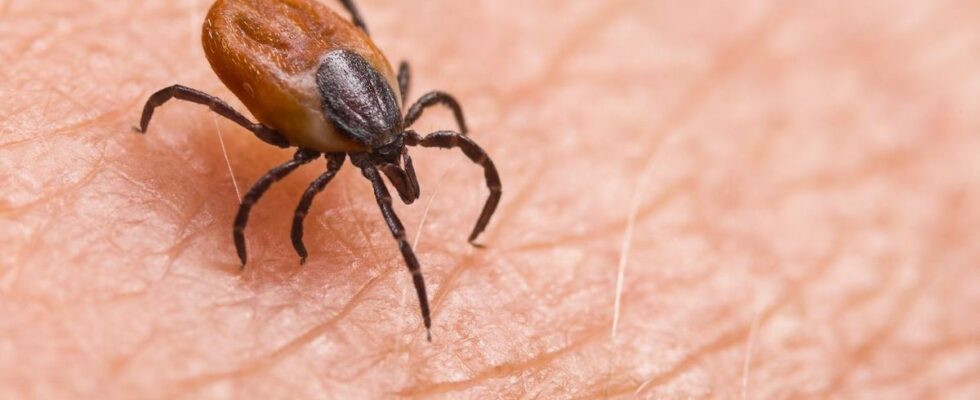Published on
Updated
Reading 3 min.
in collaboration with
Dr Gérald Kierzek (Medical Director of Doctissimo)
Medical validation:
May 16, 2024
If no human case of Crimean-Congo hemorrhagic fever has yet been detected, the giant tick, present in Occitania and the South-East, is worrying. An update on its spread and the risks incurred with Dr Gérald Kierzek, medical director of Doctissimo.
Everywhere in the South, the giant tick is rampant. First in the Pyrénées-Orientales then in Corsica, in Aude, Gard, Hérault, Ardèche, Var and Alpes-Maritimes, this parasite frightens populations, since this striped tick, originating from Africa and Asia, is believed to carry the Crimean-Congo hemorrhagic fever virus. But should we still fear its proliferation? We asked the question to Dr Gérald Kierzek, medical director of Doctissimo.
Towards a spread of Crimean-Congo hemorrhagic fever?
Hyalomma marginatum, also called “giant tick”, “is a large hard tick, recognizable by its long rostrum and its two-colored legs (whitish rings at the joints)“, explains ANSES.
They’re ticks.”hunters” which remain on the ground, hidden in plant debris. They particularly appreciate pastures, steppes or Mediterranean shrubs, unlike other ticks which are more forest-dwelling.
The problem ? This parasite is a vector of numerous pathogens, including the Crimean-Congo hemorrhagic fever virus, a common disease caused by a virus (Nairovirus) of the Bunyaviridae family.
“In humans, Crimean-Congo fever is generally limited to a flu-like syndrome with digestive problems.. But “in certain cases, it can nevertheless worsen and result in a hemorrhagic syndrome, the fatality rate of which reaches 30% in certain countries“, explains ANSES.
Prevention remains the best protection
For his part, Dr Gérald Kierzek wants to be rather reassuring.
“There are no cases of fever in France (apart from one imported case). But there is also no vaccine or treatment for this disease, which is most often benign but which can progress to hemorrhages and be fatal. The right attitude? Monitor and adopt good reflexes to protect yourself from ticks which also carry another beautiful bacteria present everywhere in France: Borrelia burgdorferi, the Latin name of the bacteria responsible for Lyme disease, transmitted by ticks. he explains.
Not every sting is responsible for an infection
Another point put forward by the doctor: not all ticks are infected and not every bite or infection causes illness.
“Lyme disease, or Lyme borreliosis, manifests itself within 30 days after the bite by an infected tick with the appearance of a red plaque that extends in a circle. This erythema migrans is the signature of the disease. A medical consultation is necessary and antibiotics prevent complications (neurological, joint, muscular, skin or cardiac) which sometimes occur in the weeks or months after the bite. In the event of a tick bite, don’t worry: if there is no erythema, there will be no Lyme disease! It is still necessary to detect the red patch which does not hurt and does not itch, and as ticks like warm and humid places, they often bite behind the knees, under the armpits, on the genital areas, the navel, the leather hair, neck and back of the ears,” he reveals.
Whether Hyalomma ticks or Ixodes ricinus, vector of Lyme diseaseit is possible to prevent tick bites and the diseases they transmit by the following good reflex actions:
- Inspect yourself, especially when returning from your walks in the forest;
- Be careful all year round but even more so between spring and fall;
- When walking: cover your arms, legs and neck with long clothes, tuck the bottom of your pants into socks, wear closed shoes and once you get home, carefully inspect your skin;
- If necessary, use skin repellents with marketing authorization (AMM), carefully respecting the recommendations for use;
- Also have a tick remover on hand, available in pharmacies;
- Monitor the sting area for several days and consult your doctor if you experience symptoms (redness, fever, etc.).

